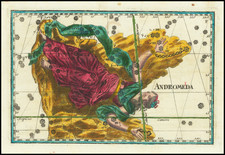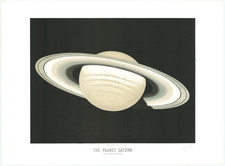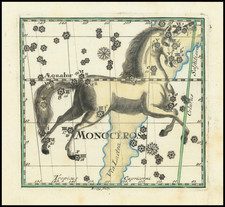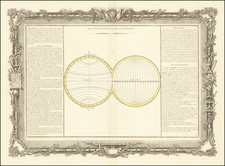A rare depiction of Thomas Wright's Orrery, which is an instrument that represents the revolution of the heavenly bodies through many complicated movements. The orrery takes its name from Charles Boyle, the fourth Earl of Orrery, who was one of the first to own one.
Wright was King George II's instrument maker and designed a new base plate for the orrery in the form of concentric rings, each bearing a planet. The semi-circular arches over the top of the base represent the Tropic of Cancer and the Arctic Circle. Additionally, the engraving shows the ‘moveable horizon,’ which is hinged to allow for motion.
The engraving shows the orrery in great detail, with each planet represented as a small sphere orbiting the sun at a fixed distance. The orbits are depicted as circles with the planets presumably moving in a counterclockwise direction. The planets are labeled with numbers corresponding to a key at the right.
The orrery is mounted on a base, which is decorated with intricate designs and inscriptions. The base also features a handle (number 14), which can be used to adjust the position of the planets and simulate their movements ("one revolution of which shews a days progress in all the Orbs"). The overall design of the orrery is elegant and sophisticated.
This engraving is significant because it is a rare separately published image of the orrery. It provides a valuable historical record of the device and its design, and it also highlights the technical and artistic skill of the engraver and artist involved in its creation.
A Philosopher Lecturing on the Orrery
The engraving brings to mind Joseph Wright of Derby's famous 1766 painting of a group studying an orrery, doubly so because of the name shared by our instrument maker and the painter. A quick review of the family tree of the Wrights of Derbyshire and Staffordshire shows no immediate familial connection between the two. However, the likeness between the two orreries is so striking as to be worthy of further inquiry.
Rarity
Rare. The Science Museum, London appears to have an example of the engraving.
RBH records an example of the engraving having sold at Christie's in 1975 for 45 GBP.
No copies traced in OCLC.
Thomas Wright was a British mathematical instrument maker, who was appointed "Mathematical Instrument Maker" to the Prince of Wales (later King George II).
Thomas Wright was apprenticed to John Rowley in the Company of Broderers, who was Master of Mechanics to George I. Wright remained with Rowley until he was freed in1715 and he took over the business in 1728 on Rowley's death. Wright's premises were at “the sign of the Orrery and Globe”, near Salisbury Court, Fleet Street, London.
Wright made many different instruments. In the History of Science Museum in Oxford there are examples of his orrery, theodolite, waywiser, drainage level and several portable sundials. Royal Museums Greenwich has a horizontal sundial, circumferentor (surveyor's compass) as well as a drawing set in its collection. The collection in the Science Museum, London includes a planetary model, horary quadrant, callipers, and a flexible drawing curve and he was credited with expanding the Grand Orrery at the Science Museum to include Saturn. A fine mechanical equinoctial dial is in the collection of the Metropolitan Museum of Art, New York.
In 1731, Thomas Wright and Richard Cushee printed a book by Joseph Harris titled "The Description and Use of the Globes, and the Orrery: To Which Is Prefixed, By Way Of Introduction, A Brief Account Of The Solar System" which includes a lengthy description of an orrery and an advertisement: "The great encouragement Mr. Wright has had for many years past in making large Orreries, with the motions of all the Planets and Satellites, and the true motion of Saturn’s Ring, has made him so ready and perfect, that Gentlemen may depend on having them made reasonable and sound, not liable to be out of Order."











![[Tycho Brahe Celestial Model & Time Clock]](https://storage.googleapis.com/raremaps/img/small/33354.jpg)

![[Aquarius]](https://storage.googleapis.com/raremaps/img/small/79552.jpg)
